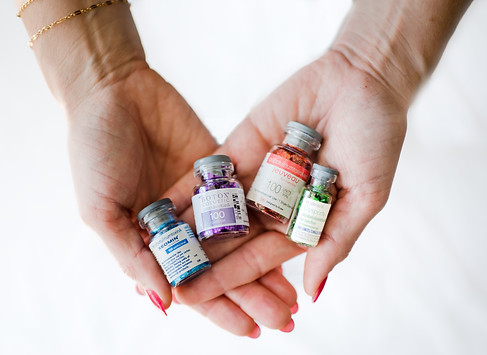%20copy.png)
Frequently Asked Questions
We wouldn't offer a treatment that wasn't safe or proven.
Pre-treatment
-
Avoid medications/supplements that can cause bleeding and swelling post injection, such as: vitamin E, aspirin (only if your prescribing doctor has approved this), NSAIDs (motrin, ibuprofen, advil, aleve), ginkgo biloba, ginseng, St. John's Wort, and/or omega 3/fish oil for seven days prior to treatment.
-
Avoid alcohol 24 hours prior to treatment.
-
Discontinue retinol use two days prior treatment.
-
Please contact me if anything changes in your medical history, health status, and personal activities that my be relevant to treatment.
-
If you are pregnant or nursing I will not inject you with Neurotoxins, Derma Fillers, or Sculptra. You are also not a candidate for chemical peels.
-
If you are not feeling well, have a rash, cold sore or blemish in the area being treated please reschedule.
Day of treatment
Arrive at your appointment with a "clean face" please do not wear makeup.

Neurotoxins
What is Botox?
Botox is a neurotoxin that has been used safely and successfully for years to treat muscles that case wrinkles. Botox is a brand name of a toxin made by bacterium Clostridium botulinum. There are other brands, such as Dysport, Jeuveau, Xeomin, and most recently Daxxify. Botox is the term you hear most often because it was the first injectable botulinum toxin, it was also approved for cosmetic uses by the FDA in 2002.
How does Botox work?
Botox is a neurotoxin, it targets the nervous system by disruption the nerve signaling processes that stimulate muscle contraction. Botox "blocks" signals from the nerves to the muscles. That makes wrinkles relax and line soften. The effects are temporary.
How long does Botox last?
Botox results last anywhere between 2-6 months. Dose equals duration and not everyone requires the same dose. Your body makes new neurotransmitters, so the "blocking" effects wear off as the chemicals start circulating in your body again and the muscles are no longer inhibited. As you continue getting Botox, those wrinkles will stay soft or never form at all.
How long do Botox injections take?
Getting Botox only takes a few minutes and no anesthesia is required. Botox is injected with a fine needle into specific muscles with minor discomfort.
Which muscle relaxer is right for you?
Each neurotoxin has a slightly different "personality". Depending on your goals and muscle strength we can help direct you on which neurotoxin is best for you.
When should I schedule a treatment?
It is recommended to schedule Botox six to eight weeks or a minimum of a month before any event. Remember it takes a full two weeks to see benefits of the treatment, if any touch ups are needed it is nice to have the time necessary to see the full results. It is easier to prevent than to reverse, schedule your appointments every three to four months.

Dermal Fillers
Where are dermal fillers used?
Dermal fillers are used to create volume, replace volume due to aging, and emphasize facial contours. They are a great nonsurgical way to minimized fine lines and wrinkles to create a refreshed, youthful look. Fillers can even but used to improve facial feature symmetry. They are best used for lips, cheeks, smile lines.
When should I get dermal fillers?
Like neurotoxins, we recommend getting dermal fillers a month prior to a big event. While the results are immediate, there is a healing process that can take two to six weeks. Also, avoid dental work (including standard teeth cleaning) at least two weeks prior to treatment and one month following treatment. Please also avoid getting any vaccinations two weeks prior or after any scheduled dermal fillers. Fillers are also contraindicated if there is history of infection. If you are on antibiotics, you should not be having HA filler injections. If you have a history of cold sores, premedication of acyclovir/Valtrex should be taken twice a day for two days prior and three days after treatment. We also recommend you not travel/fly up to three days post injection, for concerns of VO. Anytime a needle pokes through the skin, there is a chance of bruising, swelling, and redness. It is also recommended to add volume slowly. For some procedures, multiple injections over the course of three to four months are necessary for full effects which may last up to two years.
Are there different types of dermal fillers?
There are serval types of dermal fillers. I currently offer hyaluronic acid-based filler and Sculptra the only FDA-approved poly-L-lactic acid (PLLA) collagen biostimulator.
Are fillers safe?
Fillers are considered to be non-surgical and non-invasive treatments that are designed to restore lost facial volume and are generally considered safe. They have been used since the early 1990s and approved by the FDA in 2003. With that being said, there is a risk of swelling, redness, bruising, allergic reaction, infection, vascular occlusion, biofilm, malar edema, delayed onset nodules, tissue ischemia and/or necrosis . Hyaluronic acid is a naturally-occurring molecule that can be found in the sub-dermal layers of the skin. If you are unhappy with the results of your filler, it is possible to undo/partially removed the HA filler through dissolving it.

Aftercare
After each procedure you will receive a text with aftercare instructions to have on hand. If any excessive swelling, bleeding, discoloring, or pain occurs, please call me.
